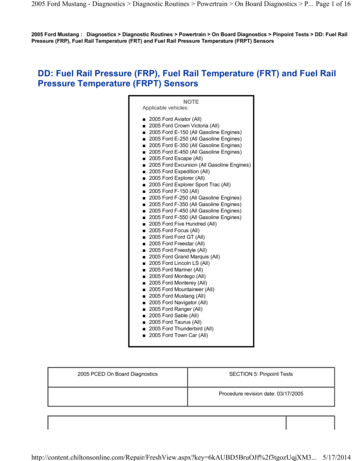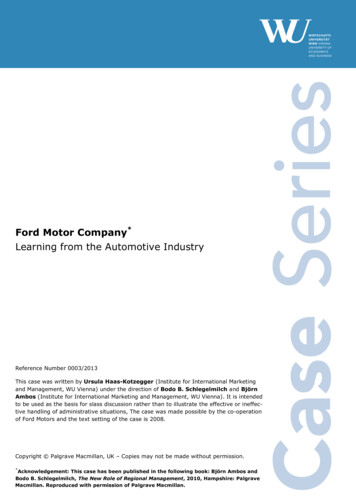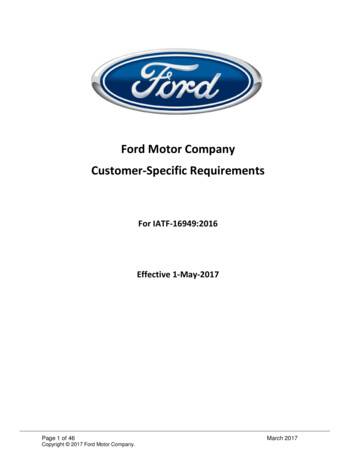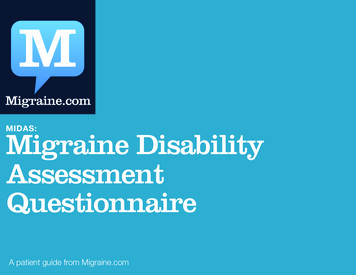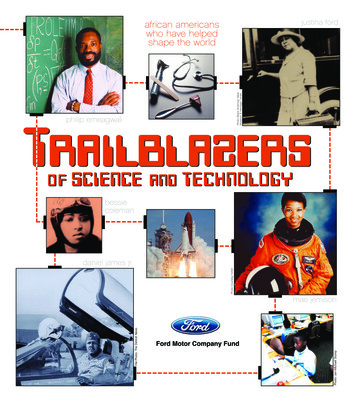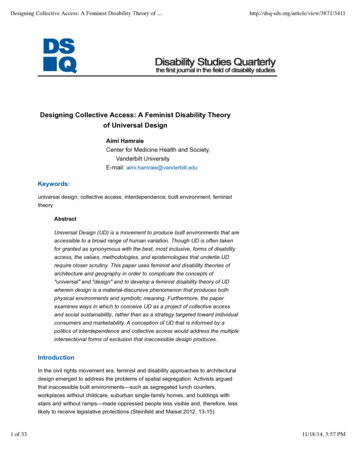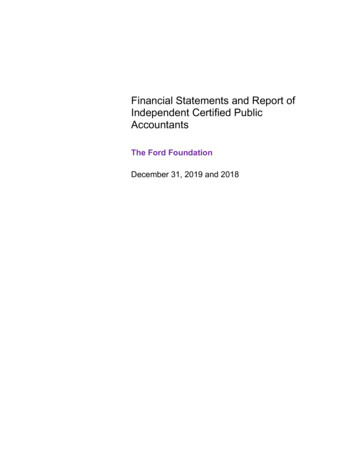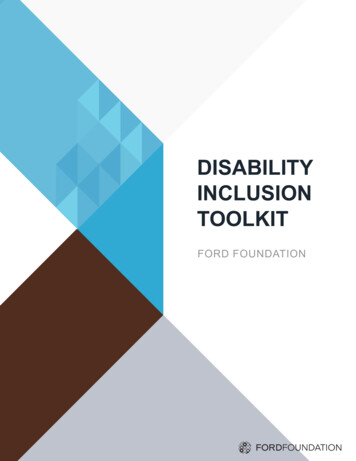
Transcription
DISABILITYINCLUSIONTOOLKITFORD FOUNDATION
2Annual Report 2020CONTENTSBackground Purpose03Introduction to Disability Inclusion04Disability Inclusion Diagram07A Guide to Disability Employment08Hiring Practices11Retention & Promotion22A Guide to Accessbile Event Planning24Stages of Event Accessibility for Accessibility26Pre-Event Planning26Event Day37Post-Event Evaluation38Virtual Event Planning40Toolkit Terminology & Definitions50Language Guidelines54Acknowledgements56
UND PURPOSEDear Social Change Makers:Given the deep inequality faced by disabled people and philanthropy’s lack of experiencesupporting disability, social justice movements have mostly failed to include disabled people aspartners, leaders and agents of change. People with disabilities often remain in a laundry listof marginalized groups to be targeted rather than a powerful community to engage, organizeand advocate with. Most social justice and human rights organizations have little experience orexpertise to advance disability inclusion in their organizing or policy work.It is with this reality in mind that we share the Disability Inclusion Toolkit, commissioned by theFord Foundation’s Civic Engagement & Government (CEG) program. This toolkit, written anddesigned by key leaders in the disability community, Mia Ives Rublee (writer) and Andraéa LaVant(copy editor & designer) provides key resources to help social justice organizations advancedisability inclusion in their work. Through a series of interviews with a set of CEG grantee partners,Mia Ives-Rublee sought to explore and understand their organizational capacity needs arounddisability inclusion.These conversations, coupled with Mia’s expertise in disability inclusion led to the development ofa toolkit that focuses on disability 101 materials (definitions & language guidelines) and guidanceon accessible in-person and virtual events, social media, and disability inclusive employmentpractices from recruitment to retention. While this knowledge building project prioritized the patternsand needs that came out of the conversations with CEG’s partners, the CEG team recognizedthat this information could be useful to other non-disability groups. Therefore, we pivoted ourdissemination strategy to ensure that this toolkit serves as a public good to any organization thatcan benefit from the tools, tips, and guidance offered in these pages.Reasonable Accommodations ProcessPeople with disabilities are a diverse group of individuals with varying needs. There is no one-sizefits all accessibility approach, which is why this toolkit emphasizes the need to create pathways forpeople to share their access needs and solicit feedback to identify areas of improvement. With thisunderstanding in mind, we share that this toolkit is 508 compliant, meaning that it is screen readercompatible for individuals who are low vision, blind, and/or require a screen reader due to physical,intellectual and/or developmental disabilities. We recognize that it may not meet the needs of somepeople with disabilities, for example those who require plain language materials. As we seek tomodel disability inclusion in our grantmaking and internal practices, we want to fully disclose thelimitations of this toolkit.
4Annual Report 2020DISABILITY INCLUSION TOOLKITINTRODUCTION TO DISABILITY INCLUSIONBy Mia Ives-RubleeOn September 12, 2016, Ford Foundation President Darren Walker committed theFord Foundation to work on disability justice and inclusion. His essay titled, “Ignoranceis the enemy within: On the power of our privilege, and the privilege of our power” discussedhow disabled leaders in the community helped show him his own ignorance on the topicand explained the need to commit to ensuring the disability community is fully included inequal rights and justice work. Since then, the Ford Foundation has reached out to numerousleaders in the disability community to help them map out a plan to be more inclusive of ourcommunity.The Ford Foundation’s Civic Engagement & Government (CEG) program requested I createa toolkit to increase their grantees’ understanding of how to increase disability inclusionwithin their programmatic work and/or organizational practice by using a disability justicelens. This was a significant request, as disability inclusion in its previous forms have neverbeen enough to help tear down all the barriers keeping disabled people from participatingin civic engagement organizations.Disability inclusion, in its original form, often relied heavily on the medical model and charityframework of disability. It saw disabled people like me as broken individuals that neededfixing and that any inclusion-focused activities were acts of charity. It devalued what aperson like me could contribute by leaving us out of decision making processes and onlyseeing us as passive objects with no perspectives on how we want to be included.This toolkit discredits those models and emphasizes the importance of including disabledpeople throughout the process of organizational change. An organization must commit towelcoming disabled people to participate throughout their organization and ensuring weare able to actively contribute. People with disabilities must be included in planning andleadership roles.It saw disabled people like me as broken individuals that neededfixing.It devalued what a person like me could contribute by leavingus out of decision making processes and only seeing us as passiveobjects with no perspectives on how we want to be included.”Mia Ives-Rublee4
TIONAL CHANGEIn order to become more disability inclusive, organizations will need to cycle through systemicchanges to break down the intentional and unintentional barriers that have historically keptdisabled people from participating. Think of organizational change like a ferris wheel (seea more detailed version here):Organizational change is a never ending cycle of identifying, committing, evaluating,researching, creating, implementing, and reviewing. After reviewing, organizations willgo back to identifying issues and cycle through the process again. In essence, there willalways be room to improve and no organization should remain static.The Cycle123Organizations should always begin by identifying the change they would like to see.Your organization has taken the first step just by deciding to review this toolkit.An organization’s leadership must commit to this change. Without this commitment,an organization will remain rudderless as they will have significant difficultiesimplementing the policy changes needed to make their organization more friendlyto disabled people.Leadership and staff should review organizational policies. An organization maychoose to do a full review of all its policies or it may target just a few to get started.5
DISABILITY INCLUSION TOOLKIT6ORGANIZATIONAL CHANGE45Seek input from disabled experts. It’s important to include disabled peoplethroughout the process. However, it is especially important to include them asyou begin to think about creating new policies. Disabled experts can be staffmembers, disability inclusion contractors, policy experts, board members, andvolunteers who have disabilities. It is good to get someone with a disability tohelp. It is even better to get a disability expert who has a better understandingaround a wider variety of disabilities, ensuring your policies are as inclusive aspossible.With the help of your disabled experts, use this toolkit to help your organizationwork on improving its policies to make them more disability included. This toolkitincludes introductory and more advanced guides on improving an organization’spolicies around event planning and employment. It also includes introductoryguides for being more disability inclusive in social media and disability-specificlanguage guidelines.6Evaluate! It is always important to evaluate to see the progress your organizationhas made. This toolkit includes two surveys, a workplace disability climate surveyand an accessible event survey.7Do it all over again!FINAL THOUGHTSWorking on improving disability inclusion in organizations can be challenging, but verysatisfying work. Use this toolkit to help guide you. But also use your disabled inclusion experts,disabled community members, and research to help grow your arsenal of tools to becomemore inclusive. You may run into barriers, especially when trying to find disabled experts,employees, and participants. Understand that disabled people still face numerous barriers andtrust issues when it comes to interacting with non-disabled people. It may take time to buildenough trust so that more disabled people come out to participate in your events, volunteer,and apply for your jobs. All the work your organization puts towards disability inclusion will go along way and the disability community will react positively to your dedication and persistence.If you have any questions about the toolkit, please contact Claribel Vidal atc.vidal@fordfoundation.org.
ty Inclusion Diagram of Change7
8Annual Report 2020DISABILITY INCLUSION TOOLKIT8A GUIDE TO DISABILITY EMPLOYMENTHiring disabled employees is one of the best ways to build a disability inclusive organization.People with disabilities are a highly untapped resource and can significantly improveorganizational diversity and outcomes. In fact, evidence proves the perspectives, qualities,and experiences disabled employees bring to the workplace help organizations yield avariety of positive results. These include better employee retention, increased brand loyalty,enhanced staff morale, higher work quality, greater innovation, and so much more.Often stereotypes and preconceived ideas aboutthe needs and abilities of disabled people causeemployers to feel apprehensive about hiringdisabled employees. By being open and willing tothink creatively and adjust attitudes, organizationscan ensure they are prepared to hire and retainemployees with disabilities.Before building out a hiring plan, organizationsshould understand disability-focused laws andbest practices to ensure they can effectivelysupport job candidates and employees withdisabilities.The Americans with Disabilities Act (ADA), first signed into law in 1990 and amendedin 2008, provides the framework to understand the rights of employees with disabilitiesand the responsibilities of employers. Title I of the ADA covers disabled employees whowork at private entities, state and local governments, employment agencies, and laborunions. While it refers to entities with 15 or more employees (and those who are subjectto federal contracting and federal assistance laws), all organizations should strive tomeet and exceed ADA rules and guidelines.By being open and willing to think creatively and adjustattitudes, organizations can ensure they are prepared to hireand retain employees with disabilities.”
DISABILITYAnnualINCLUSIONReportTOOLKIT2020STEPS FOR CREATING AND IMPLEMENTINGDISABILITY INCLUSIVE EMPLOYMENT PRACTICESYou may or may not be aware, but it’s quite likely your organization has already hired adisabled employee or has had an employee become permanently or temporarily disabled.Unfortunately, it’s common for employees with disabilities to feel their prospective or currentwork environments are unwelcoming and, thus, feel unsafe disclosing their disabilities toemployers. Below are steps organizations can take to proactively create more welcomingenvironments for disabled employees.ESTABLISH BUY-IN01From senior leadership to Human Resources to other organizationaldepartments and teams, all entities within an organization should committo prioritizing disability inclusive hiring and retention. Employers candemonstrate this commitment by sharing formal statements from executiveleaders about the importance of focusing on disability issues (check out theFord Foundation statement from Darren Walker, President). They can alsoprovide training for current employees on disability-inclusive topics such asdisability etiquette, reasonable accommodations, and/or disability justice.ASSESS02Organizations should thoroughly review policies, procedures, andenvironments that may affect a disabled person’s ability to obtain andmaintain employment. This should include assessing application andinterview processes, accommodation request procedures, physical andsensory accessibility, and much more. Organizations can hire contractorsfrom the disability community to review policies, practices, and procedures.They can also develop working groups of disabled community members tohelp complete these reviews (these should also be paid positions).9
10Annual Report 2020DISABILITY INCLUSION TOOLKIT10IMPLEMENT03After assessing the issues, gaps, and barriers disabled employees maypotentially encounter within your organization, it’s important to create andimplement plans to address these areas. Organizations should developimplementation plans with input from disabled members and employees inthe organization. It’s important to reveal this plan to the entire organization.It’s even better to share the plan with the public as well.EVALUATE04Organizations should continuously track progress and obtain feedback fromemployees. Evaluation is critical to understand where your organizationstarted and how much progress it is making. Evaluations can include reviewingdata that pertains to disability (such as measuring how many employeesself-identify as having a disability or chronic health condition and how manyemployees request work accommodations). Evaluations can also includesurveys asking employees about their views on the organization’s attitudeson disability within the workplace.The perspectives, qualities, and experiences disabledemployees bring to the workplace help organizations yielda variety of positive results: better employee retention,increased brand loyalty, enhanced staff morale, higher workquality, greater innovation, and so much more.”
DISABILITYAnnualINCLUSIONReportTOOLKIT2020HIRING PRACTICESHiring qualified workers with disabilities takes diligence and persistence. According to theUS Bureau of Labor Statistics, only 30% of disabled people are employed (compared to74% of non-disabled people).There are numerous factors that influence the low rate of employment for people withdisabilities. Factors can include:1. Employers’ unconscious bias or stigma about disabled people’s ability to perform jobs2. Inaccessibility of work environments3. Lack of opportunities to resources like education, transportation, housing, etc. thatnegatively affect a disabled person’s ability to qualify for positions or even apply for a jobOrganizations can take steps to make their hiring processes more accessible to the disabilitycommunity. Here’s how:RECRUITMENTWords, phrases, andimages used in a jobSome recruitment tactics can deter qualified disabledcandidates from applying for jobs. Organizationsmust review their policies and procedures tounderstand if they have inadvertently createdunnecessary recruitment barriers.posting can eitherattract or deter adisabled candidatefrom applying.Inclusive Verbiage & ImageryWords, phrases, and images used in a job posting can either attract or deter a disabledcandidate from applying:AEnsure supervisors carefully review the essential tasks of a position and take outanything extraneous. When creating a job posting, often hiring managers use atemplate which includes physical demands that aren’t essential to a position. Oneof the most prevalent essential tasks used in job postings is the requirement ofthe candidate to “be able to lift over 25 lbs.” Many positions, especially in officeenvironments, don’t actually need an individual to be able to lift this weight. However,phrases like these can immediately discourage a potential, otherwise qualifiedapplicant from applying.11
12Annual Report 2020DISABILITY INCLUSION TOOLKIT12RECRUITMENT (cont.)Inclusive Verbiage & Imagery (cont.)BCDInclude current universal practices or benefits you already provide at your organization.These can include flexible work schedules, telecommuting, paid family and medicalleave, etc. Many of these benefits, sometimes viewed as accommodations, incentivizecandidates with disabilities to apply for open positions.Often in job postings, organizations make statements encouraging women and peopleof color to apply. Organizations should add people with disabilities to this list, whichwill communicate to potential candidates that you welcome them. Additionally, ensureyour postings clearly state how a disabled applicant can request accommodations tocomplete an application and/or interview.In addition to stating that your organization prioritizes hiring disabled employees,job postings and advertisements that include images should also include imagesof employees with disabilities. Although many disabilities aren’t visible, depictingemployees with disabilities in images can encourage disabled job candidates to apply.Some recruitment tactics can deter qualified disabled candidates from applying for jobs.Organizations must review their policies and procedures to understand if they have inadvertentlycreated unnecessary recruitment barriers.Accessible AdvertisingHiring managers know that advertising is essential to attracting the perfect job candidate.However, many don’t understand that some forms of advertising remain inaccessible topotential applicants with disabilities.Advertising a position in multiple formats and platforms will ensure you are able totarget a more diverse group of people. Formats can include advertising on the radio/tv,websites, social media, etc. Electronic ads and online applications, whether video or print,should be accessible for screen readers and other assistive technology devices. Use theWCAG web accessibility requirements to learn how to make your web content more accessibleto people with disabilities.
ENT (cont.)Targeted AdvertisingOrganizations that prioritize hiring disabled employees should connect withdisability-focused agencies/organizations and job boards targeting the disabilitycommunity.This can include:Connecting and partnering with state and local disabilityemployment agencies/organizationThese partnerships can help source potential highly qualified applicants. Examplesof state and local agencies and organizations to partner with include: Centers for Independent Living Employment Networks (EN) State Vocational Rehabilitation Agencies Department of Veteran Affairs Vocational Rehabilitation and EmploymentServices College/University Disability Services OfficesPosting open positions to websites that target disabledapplicants.Examples include: AAPD Career Center abilityJOBS AbilityLinks.org Association of University Centers on Disabilities (AUCD) disABLEDperson, Inc. Getting Hired Job Opportunities for Disabled Veterans National Business & Disability Council OutAbility Connect RecruitDisability.org Talent Acquisition Portal WRP.jobs13
LITY INCLUSION TOOLKIT14INTERVIEWSInterviews are an essential time for hiring managers and supervisors to get to know a jobcandidate. They are also great opportunities for candidates to determine if an organizationand position fits their needs and goals. However, when an employer is unfamiliar withproviding accommodations for candidates with disabilities or is influenced by unconsciousbias against individuals with visible and hidden disabilities, the interview process will likelybe unsuccessful.Before proceeding with intentional disability-inclusive hiring processes,organizations should review their interview practices to ensure disabled applicantshave a fair and equal opportunity to be hired for any available position.Here are a few tips to help you develop strong inclusive interview practices:123Provide disability etiquette/unconscious bias training to hiring managers andsupervisors to reduce bias (conscious or unconscious) throughout the hiring process.(See Resource List for recommended trainers).Review job interview processes to determine which parts of the processes areessential. If an individual has a disability that affects social interaction, speech, ortheir affect, are there other methods the organization can use to determine if anapplicant has the skills needed for the job? This can include allowing the applicant toprovide work samples, creating job simulations, etc.Inform candidates of the tasks they must complete and ask ALL candidates if theyrequire accessible accommodations for the interview. Do not assume you know acandidates’ needs. (Note: Never require a candidate to disclose that they have adisability. For information on the ADA requirements around non-discrimination duringthe hiring process, please visit the EEOC FAQ webpage. The Job AccommodationsNetwork (JAN) also provides a DOs and Don’ts list interviewers should review beforehandling an interview.
DISABILITY INCLUSION TOOLKITINTERVIEWS (cont.)45Have a list of vendors available to accommodate certain requests (i.e. ASLinterpreters, ramps, accessible equipment rental, etc.) so you don’t have toscramble to find a vendor during the hiring process. (See Resource List forrecommended vendors).Do not assume a location is physically accessible. Examine the location, entrances,and walkways to look for any barriers. Use the Guide to ADA Standards to helpyou look for them. If a candidate has a physical or sensory disability, inform themof accessible routes or barriers before the day of the interview.Sample Organizational Statement:Interview Invitation EmailHere’s an example of an organizational statement to includeon your interview invitation email:“[Organization name] is committed to providing EqualEmployment Opportunity (EEO) to employees andapplicants for employment regardless of color, religion, sex,national origin, age, disability, genetic information, sexualorientation or political affiliation. [Organization name] iscommitted to complying with all applicable federal, stateand local laws that pertain to employment, and to providinga work environment that is free from discrimination of anykind.If you require accommodations, please make the requestat least forty-eight (48) hours in advance of the time theaccommodation is needed. You may submit your request to[contact name and email address.]”Thank you,[Insert name and title here]15
16Annual Report 2020DISABILITY INCLUSION TOOLKIT16REASONABLE ACCOMMODATIONSReasonable accommodations must be provided to both job applicants and employees whorequest them. Individuals with disabilities differ greatly and require different accommodationsbased on personal needs and the requirements of the job. Additionally, it’s important toremember that not all employees with disabilities require accommodations.Reasonable Accommodations ProcessEach employer should have a process to review reasonable accommodation requestson a case-by-case basis. If an accommodation request places an “undue burden” on theorganization, organizations should make every effort to find alternatives before completelydenying a request.Employers should review their reasonable accommodation request guidelines in theiremployee handbooks. Many organizations use templates to create their employee handbooks.An organization’s leadership should review the reasonable accommodations section in thehandbook and adjust wording to align with the organization’s individual request process.Providing explicit guidelines on how to make a reasonable accommodation request will makeit simpler and less stressful on both the employer and employee.What Is a Reasonable Accommodation?A ‘reasonable accommodation’ is a “modification or adjustment to a job, thework environment, or the way things usually are done that enables a qualifiedindividual with a disability to enjoy an equal employment opportunity.”Put more simply, job accommodations allow disabled people to do their jobs– they are not extras or special treatment. The ADA requires employers of15 or more employees to provide reasonable accommodations. However,all organizations should aim to follow these rules and guidelines, no matterthe size.
LE ACCOMMODATIONS (cont.)For example, an average template for many organizations’ reasonable accommodationrequest reads as follows:“Employees with a disability who believe they need a reasonableaccommodation to perform the essential functions of their jobshould contact the Director of HR and Finance.”This template doesn’t provide enough information for an employee or employer tounderstand the full process to request a “reasonable accommodation” or what qualifiesas a disability. Organizations should be upfront about the process and help define terms.The Job Accommodation Network’s Sample Accommodation Policy and Process providesa strong example of an organization’s accommodation request policy. Note the detailand definitions in the policy included that help the reader understand key terms suchas “workplace reasonable accommodation,” “interactive process,” and “accommodationsconsultant.” It also provides specific timelines and responsibilities of each key player inthe process. Finally, it provides an option for an employee to appeal the decision.Types of Reasonable AccommodationsThere are numerous types of reasonable accommodations to meet the jobperformance needs of employees with disabilities. These vary widely based on theperson’s medical condition, form of disability, and role within the organization. Respondingpromptly and appropriately to reasonable accommodation requests can help ensure theemployee and employer develop a positive and trusting relationship. Each request shouldbe treated individually in a highly interactive process that ensures full involvement of HR,managers, and the employee. This should all be outlined in the employee handbook.When working with employees or applicants to discuss their accommodation needs, adesignated person within the organization should meet with them to discuss their individualneeds. Some organizations have a representative from the HR department, whileothers have a formal reasonable accommodation coordinator. HR personnel handlingaccommodations should familiarize themselves with the Job Accommodations Network(JAN), which provides extensive examples of accommodations for specific disabilities.However, note that there are a variety of ways to accommodate concerns or needs thatoccur in the interview process or workplace, thus, coordinators shouldn’t limit themselvessolely to these examples.17
18Annual Report 2020DISABILITY INCLUSION TOOLKITTIPS FOR CREATING AN INDIVIDUALIZEDREASONABLE ACCOMODATION POLICY Explicitly state that your organization provides reasonable accommodationsfor applicants and employees who need them for medical or religiousreasons, as required by law. Identify and provide contact information for the person in charge of handlingthe requests. State an estimated timeline for managers to respond promptly to therequests. Include that, in certain circumstances, the organization may need furtherdocumentation. This may include letters or medical information to determinethe type of accommodation needed. This should be a simple process andemployers should not request the employee or candidate’s full medicalhistory. Explain how the organization plans to protect the informationcollected, for example, ensure it will be kept in a separate file from thegeneral employee file. Explain how applicants and employees can report discrimination relatedto requesting or using reasonable accommodations. Describe theconsequences of violating the reasonable accommodation policies.18
DISABILITYAnnualINCLUSIONReportTOOLKIT2020HIRING PRACTICES (CONT.)REASONABLE ACCOMMODATIONS (cont.)There are three categories of “reasonable accommodations”*:I.“modifications or adjustments to a job application process that enable a qualifiedapplicant with a disability to be considered for the position such qualified applicantdesires; orII.modifications or adjustments to the work environment, or to the manner orcircumstances under which the position held or desired is customarily performed,that enable a qualified individual with a disability to perform the essential functionsof that position; orIII.modifications or adjustments that enable a covered entity’s employee with adisability to enjoy equal benefits and privileges of employment as are enjoyed by itsother similarly situated employees without disabilities.”*U.S. Equal Employment Opportunity Commission., and U.S. Equal Employment Opportunity Commission.“Enforcement Guidance on Reasonable Accommodation and Undue Hardship under the ADA.” EnforcementGuidance on Reasonable Accommodation and Undue Hardship under the ADA U.S. Equal EmploymentOpportunity Commission. Accessed June 14, 2020. l.19
DISABILITY INCLUSION TOOLKITExamples of Reasonable Accommodations Telework/Working from home or other remote locations Modified work schedules Changing required start and end times Allowing for more frequent breaks Communication modifications ASL or ESL interpreters for Deaf individuals or individuals who are hardof-hearing (HOH) Qualified personal readers for blind people, people with low vision, orindividuals with learning disabilities Text-based communication for autistic people, people who have auditoryprocessing disabilities, and people who have speech related disabilities Simple, direct language usage to help individuals with intellectualdisabilities Allowing use of a job coach Public and private disability organizations sometimes provide jobcoaches to help assist an individual in learning new job tasks or helpingthem complete t
On September 12, 2016, Ford Foundation President Darren Walker committed the Ford Foundation to work on disability justice and inclusion. His essay titled, "Ignorance is the enemy within: On the power of our privilege, and the privilege of our power" discussed how disabled leaders in the community helped show him his own ignorance on the topic
